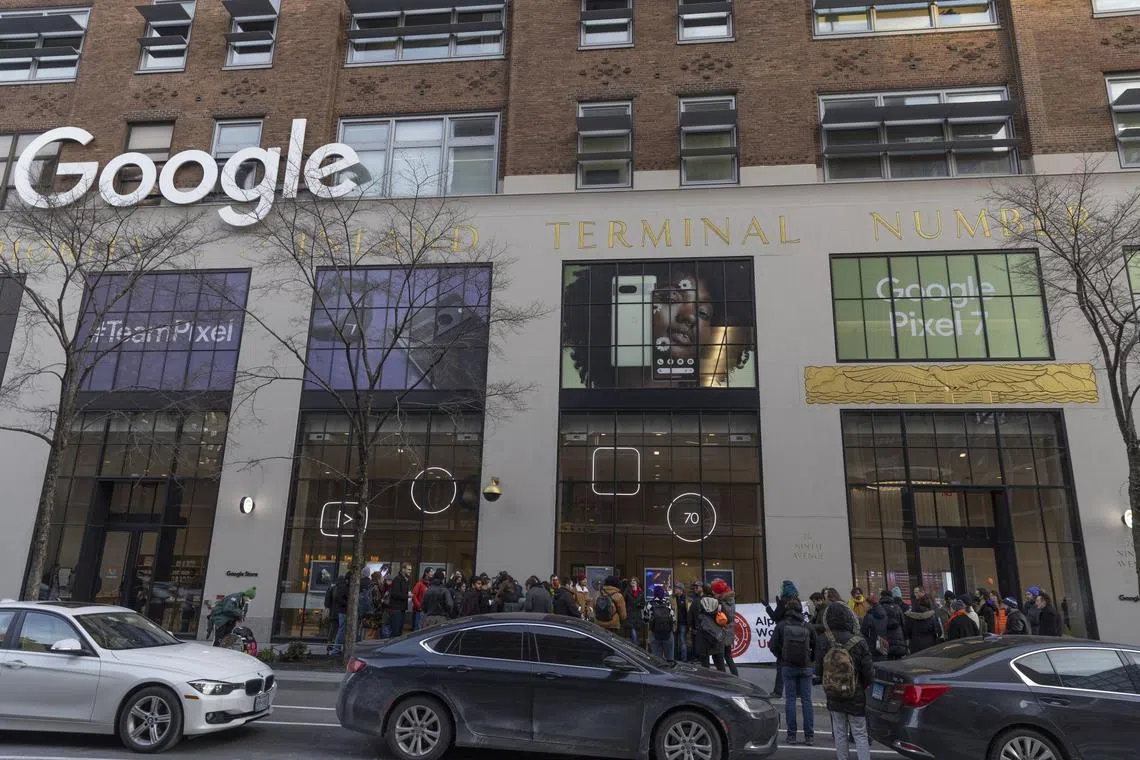Commentary
Tech CEOs will pay a harsh price for these job cuts
Sign up now: Get ST's newsletters delivered to your inbox

Demonstrators during an Alphabet Workers Union rally in New York on Feb 2, 2203.
PHOTO: BLOOMBERG
Tim Culpan
Follow topic:
TAIPEI – It is hard to feel sorry for Silicon Valley tech workers. From high salaries and generous stock options to nap pods and unlimited time off, they are among the most privileged class of employees in the world. Conversely, there is no denying that these pampered staff engineered a technology revolution that has brought untold economic and social value to the entire planet.
Yet there is a category of people who may lament the cold-hearted approach to workforce cuts that have torn through the sector
Almost 100,000 positions have been eliminated this year alone, according to Layoffs.fyi, which tracks the data. At some point in the next few years, these job vacancies will return. We are on the cusp of an artificial intelligence boom, network speeds continue to get faster, cars will be driving themselves, and there will be more data collected and stored than Big Tech will know what to do with. Recruiters and hiring managers will be begging those same staff to return.
For the better part of two decades, the Fangs – Facebook, Amazon.com, Netflix and Google – epitomised success for a young engineer or a career-climbing manager. Add in Microsoft and Apple – let us call them the Mafangs – and you have US$7.3 trillion (S$9.7 trillion) of market capitalisation, even after a 25 per cent plunge in major stock indexes. More importantly, though, they are among the most valuable names an employee can put on his resume.
These companies pride themselves on measuring, benchmarking and rewarding performance. But rightly or not, they have recently presented to the world a sense of what they really are: callous companies that dump people in the middle of assignments or business trips with little explanation, no opportunity to bid farewell to colleagues, and no recognition that they have needs that extend beyond salaries and free lunches to a sense of dignity and appreciation.
We should not kid ourselves into believing that companies ought to display some kind of family values, as they have often pretended to do. But there is a reason why perks like on-site masseurs and free yoga classes are deployed – they help attract and retain the brightest and most creative minds, those needed to inspire new products and solve seemingly insurmountable technical challenges.
The Mafangs were seen as a stepping stone to something better – your own start-up, a job at a venture capital firm, a leadership role at a smaller, faster-growing tech company.
Corporate leaders need not be concerned if their companies are merely a rung on an employee’s career ladder. They should be worried if the firms are not.
Instead of hiring talent with drive and entrepreneurial flare who have dreams of something better, they could find themselves facing an even worse scenario: Workers see them not as a place to start or build a career, but instead somewhere to retire to, where they can live out their days safely navigating company bureaucracy until the next cycle of job cuts hands them a fat payoff; a repository for those who have nowhere else to go, and no desire to even look.
What no technology CEO wants today is to become the next IBM or General Electric, once high-flying bastions of innovation and power that became symbols of corporate morass and low morale.
While tech workers have taken the brunt of firings this time, their counterparts in finance are also feeling the squeeze. Goldman Sachs said it plans to cut 3,200 jobs, Morgan Stanley around 1,600 and Bank of New York Mellon Corp approximately 1,500 as a slowdown in public offerings and mergers hits earnings.
But now, having botched their downsizing programmes in an attempt to appease activist investors, tech firms risk being forever remembered as corporations that fired women on maternity leave in the dead of night.
This approach may boost the bottom line in the short term and assuage shareholders who crow about corporate bloat. But in a few years, they will be competing in the hiring market with a new crop of technology names, many of which popped up during the pandemic and downturn. For the established leaders, size and legacy will be less an attraction and more like an albatross that hangs around their necks.
Sure, the Mafangs will still be able to attract fresh graduates and experienced hands. But not as many, and not the best. And that is going to hurt. BLOOMBERG

